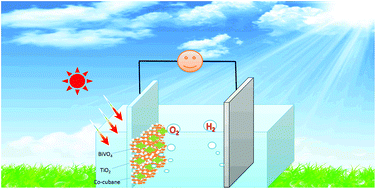Efficient photoelectrochemical water oxidation using a TiO2 nanosphere-decorated BiVO4 heterojunction photoanode †
Abstract
Constructing heterojunctions by coupling dissimilar semiconductors is a promising approach to boost charge separation and charge transfer in photoelectrochemical (PEC) water splitting. In this work, we fabricated a highly efficient TiO2/BiVO4 heterojunction photoanode for PEC water oxidation via a simple hydrothermal method. The resulting heterojunction photoanodes show enhanced PEC performance compared to the bare BiVO4 due to the simultaneous improvements in charge separation and charge transfer. Under simulated sunlight illumination (AM 1.5G, 100 mW cm−2), a high photocurrent of 3.3 mA cm−2 was obtained at 1.23 V (vs. the reversible hydrogen electrode (RHE)) in a neutral solution, which exceeds those attained by the previously reported TiO2/BiVO4 heterojunctions. When a molecular Co–cubane catalyst was immobilized onto the electrode, the performance of the TiO2/BiVO4 heterojunction photoanode can be further improved, achieving a higher photocurrent density of 4.6 mA cm−2 at 1.23 V, an almost three-fold enhancement over that of the bare BiVO4. These results engender a promising route to designing an efficient photoelectrode for PEC water splitting.



 Please wait while we load your content...
Please wait while we load your content...